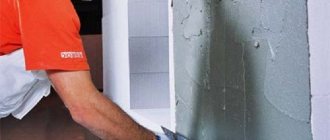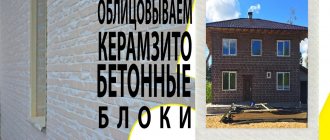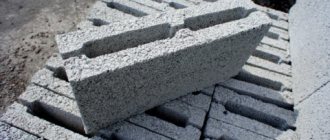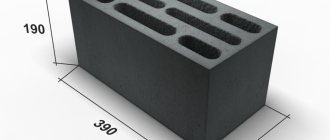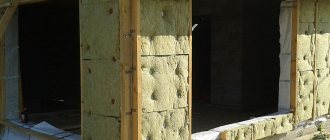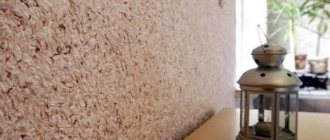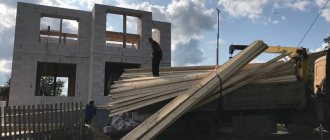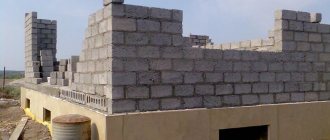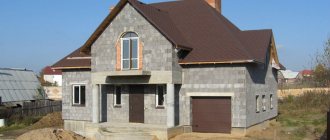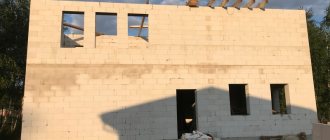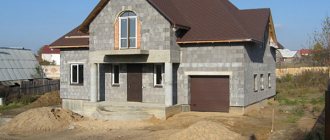Beton-House.com
Website about concrete: construction, characteristics, design. We combine the experience of professionals and private craftsmen in one place
Plastering walls
Wall structures built from lightweight concrete materials require additional finishing. Plastering expanded clay concrete blocks is one of the options for solving this problem.
Let's consider the options for materials used for plastering these products.
- Preparing the wall surface
Exterior finishing methods
The main objectives of this stage of work are to improve the exterior of the finished facility, service life without major repairs, and heat conservation. The building's cladding protects the walls from damaging external influences. When constructing a load-bearing foundation, space should be provided for future façade cladding.
Houses made of expanded clay concrete - insulation and finishing
External cladding carries not only a decorative, but also a practical load. Despite the fact that expanded clay concrete is a durable material that can withstand moisture, sharp temperature fluctuations contribute to the gradual destruction of the structure ; it is also recommended to strengthen the wall with reinforcement.
Insulation
When working on the facade, the following must be taken into account:
- practice shows that one of the best options for external finishing is the laying of a thermally insulating expanded clay concrete block, which compensates for heat loss up to 75%;
- additional insulation is mineral wool or polystyrene foam/expanded polystyrene;
- the foam is fixed on the cleaned base using an adhesive composition and is additionally secured with dowels. All seams are treated with polyurethane foam;
- mineral wool requires stripping, gluing and reinforcing wall structures to increase the strength of the structure;
- the use of penoizol will achieve sound and waterproofing and reduce thermal conductivity.
Finishing
The basic principles of work are as follows:
- expanded clay block walls lined with brick do not require additional processing, as they have a presentable appearance;
- you can use clinker tiles, stone (artificial or natural), thermal panels or siding;
- The most common option is to cover the walls with cement-sand based plaster.
Natural stone looks noble and aesthetically pleasing, however, when choosing a material, you need to pay attention to its frost resistance . Brick is not inferior to stone in its functionality and aesthetics, but is much cheaper.
Facade work using thermal panels is an economical cladding method. The panels consist of polyurethane foam and clinker tiles. This is a lightweight material that has shown effective use on strip foundations; in addition, it is very easy to install.
Ventilated facade systems effectively cover all defects in wall structures and prevent their destruction. Siding can be fragile, and its damage during operation negatively affects expanded clay concrete masonry , which is confirmed by photos and reviews related to houses made of expanded clay concrete blocks.
Wet facade on expanded clay concrete walls
The work is carried out after the walls have been leveled, all cracks have been filled with putty, and excess mortar has been removed.
Sequencing:
- First, insulation is installed, for which you can use facade foam or basalt wool;
- polystyrene foam is fixed with glue and façade dowels, cotton wool is fixed with façade dowels;
- facade fiberglass mesh is used as reinforcement, which is attached using the same dowels with fungi;
- A two-component plaster or primer layer is applied to the surface;
- the plaster is primed with penetrating primer;
- high-quality facade systems help maintain the plaster layer in a semi-plastic state, which guarantees long-term operation;
- After priming, you can begin preparing the surface for applying a decorative or paint coating.
Among all the options, you can use the following:
- decorative smalt plaster;
- “fur coat” plaster;
- decorative plaster “bark beetle”;
- painting with facade paint.
Facade varnishes or other fixing compounds are often applied to the decorative layer to protect the coating from possible destruction and contamination. Reviews for such houses made of expanded clay concrete blocks have been very positive.
Arrangement of plaster “under a fur coat”
Work can be carried out without insulation or on this layer. The method, known as finishing the facade “under a fur coat,” is carried out using spraying or spraying a solution. This method is less labor-intensive than working with other materials.
Special devices have been created for working with the solution . The device can be very simple, manually operated, or more technologically advanced, such as an air gun. At the construction site, the required mobility of the mixture is selected and finishing begins.
Wet facade on expanded clay concrete walls
The work is carried out after the walls have been leveled, all cracks have been filled with putty, and excess mortar has been removed.
Sequencing:
- first, insulation is laid, for which you can use façade foam plastic or basalt wool; the foam plastic is fixed with glue and façade dowels, cotton wool material - with façade dowels; façade fiberglass mesh is used as reinforcement, which is attached using the same dowels with fungi; two-component plaster is applied to the surface or a primer layer; the plaster is primed with penetrating primer; high-quality facade systems help maintain the plaster layer in a semi-plastic state, which guarantees long-term operation; after priming, you can begin preparing the surface for applying a decorative or paint coating.
Among all the options, you can use the following:
- decorative smalt plaster; “fur coat” plaster; decorative “bark beetle” plaster; painting with facade paint.
Facade varnishes or other fixing compounds are often applied to the decorative layer to protect the coating from possible destruction and contamination. Reviews for such houses made of expanded clay concrete blocks have been very positive.
House made of expanded clay concrete blocks - interior finishing options
The objectives of this stage of work are to protect the walls from adverse effects, model design solutions, environmental friendliness and comfort of housing. By choosing to build a house from expanded clay concrete blocks on a turnkey basis, you can get a building that is completely ready for use, with completed interior decoration.
Work can be carried out using the following materials:
- ceramic tile;
- plaster;
- lining made of plastic or wood;
- wallpaper.
Application of plaster mixtures
This is one of the most economical and affordable options, which makes it the most popular.
Working compositions can be as follows:
- decorative plaster – gives the surface a finished, aesthetically attractive look. Various textures and shades are available for sale, including glitter, stone chips, fabric fibers;
- starting – used to eliminate defects in the base layer;
- finishing – masks the unevenness of the previous coating.
The working mixture is applied to an expanded clay concrete wall using a special reinforcing mesh , with the exception of decorative coatings. To decide on the choice of plaster, you should focus on the humidity of the room. The most suitable are gypsum mixtures that provide an aesthetic appearance and are used for painting.
Which is better: heated floors or radiators?
Warm floorBatteries
The use of gypsum plaster allows you to obtain:
- ease of work;
- a warmer home compared to sand and cement based solutions;
- high adhesion, which is ensured by treating the wall with the “Concrete-Contact” solution.
Cement-sand mixtures have the following properties:
- the composition is not much different from standard wall material, which allows you to get an advantage in terms of adhesion to the working surface;
- In practical applications, manipulations with such compositions are more labor-intensive.
Houses made of expanded clay concrete blocks, video - working with facing materials
If the owner is faced with the task of interior wall cladding, you can use natural stone or ceramic tiles. No preliminary preparation of the base is required - the tiles are laid directly on the expanded clay concrete wall using cement-sand mortar.
Wallpaper coverings
Standard paper wallpaper has been replaced by more durable and beautiful materials:
- non-woven;
- cork;
- vinyl;
- liquid wallpaper;
- textile.
This type of finishing work is implemented after preliminary surface preparation. The master can carefully plaster the surface or cover the wall with plasterboard . Expanded clay concrete can withstand galvanized steel profiles or guide bars well.
The design of the cottage can be implemented in any style. The most popular are house designs made in accordance with the requirements of modern and classic design. In country houses, the “country” or “Provence” style looks especially organic. But, according to reviews from owners regarding houses made of expanded clay concrete, any design project can be easily implemented indoors.
The features of a house made of expanded clay concrete blocks are described in the video:
Cladding of expanded clay concrete walls
Very often, especially in bathhouses, ceramic tiles or natural stone are used to cover expanded clay blocks. These materials do not require preliminary surface preparation. The tiles are laid directly on the cement-sand mortar; you can also use special tile adhesive.
Expanded clay concrete walls provide wide scope for finishing materials - they perfectly withstand lining, guide beams, galvanized steel profiles and drywall.
You can order expanded clay concrete blocks in Orenburg by phone +7 (3532) 902-801.
Source
Books on the topic
Concrete mixtures. Recipe guide for builders and manufacturers of building materials - P. Mayorov - 166 rubles - link to book review
Finishing work and materials - Alexander Gorbov - 59 rubles - link to book review
Encyclopedia of an individual developer - K. Zazersky - 400 rubles - link to book review
Problems of concrete technology - Robert Lhermitte - 542 rubles. — link to book review
Construction mineral binding materials - Leonid Dvorkin - 593 rubles - link to book review
Finishing work in construction - A. Kokin - 500 rubles - link to book review
Plastering expanded clay concrete blocks
The construction of houses and other structures from expanded clay concrete blocks has long been firmly established in our daily lives. And indeed, building a building from such material is much faster than, say, from ordinary brick, and more economical. There are two main disadvantages of houses made of this material: unpresentable appearance and ventilation of the porous structure of the block. In order to improve the walls and get rid of blowing, it is necessary to plaster the surface of expanded clay concrete walls on both sides. Even if you want to clad the house with siding, there should be minimal grouting of the pores under the finishing of the facade.
Many developers believe that finishing expanded clay concrete walls is not necessary. Indeed, a building constructed from such blocks does not require mandatory finishing in some situations - the material is quite resistant to high humidity, temperature changes, and ultraviolet radiation, and can last for quite a long time - several decades. But this is correct if we are talking about some kind of garage, barn or other utility room, where functionality comes first, and parameters such as beauty, aesthetics and the special durability of the building are not very important. But if you want your house to please you and your children and grandchildren, and to last for at least a century, then you should think about it.
In what cases does it make sense to finish a house from expanded clay concrete blocks:
- if additional insulation of the room is necessary - external plaster with or without a combination of insulation and a vapor-permeable membrane;
- during the construction of a residential building - exterior and interior decoration;
- during the construction of basement floors, semi-basements, and other underground structures - a special waterproofing coating on the outside of the walls.
Why do you need to plaster the walls of a house made of expanded clay concrete?
As mentioned above, plastering the walls of a residential building built from expanded clay concrete is recommended in most cases. For what? Let's think logically. The building block discussed in this article is essentially expanded clay and a cement binder that allows it to maintain its given shape. At the same time, a huge mass of pores is formed in it, through which air circulates quite freely. As a result, unplastered walls made of such material will simply be blown out, which will make the home cold and uncomfortable.
Plastering only from the inside will not bring much reduction in the level of heat loss, since cold air will also freely penetrate the wall from the street, right down to the inner layers, take away heat, and also escape freely. This is despite the fact that there should be no drafts in this case.
If a decision is made to finish an expanded clay concrete house, it must be plastered, both inside and outside. High-quality external and internal plaster will significantly increase the service life of the walls, and will allow you to fully use the heat-insulating properties of the material - you will get something like a “thermos” that perfectly retains heat.
Types of plaster for finishing the walls of a house made of expanded clay concrete blocks
Depending on the purpose of the room and the functions of the finishing layer, the surface of a house made of expanded clay concrete sides can be covered with:
- A solution based on cement and sand. This is the simplest, cheapest (if you take into account only the cost of raw materials) and affordable option. In the recent past, when other types of ready-made dry compositions were not yet widespread on the construction market, this finishing was the only possible one. Note that this option is not the best and has a serious drawback, which will be discussed below.
- Special mixtures based on cement, various additives, plasticizers and fillers. This plaster is more convenient to use, more durable, and has a number of positive properties.
- Water-repellent compounds - to protect the walls of houses that have to work in difficult climatic conditions, or for buildings located below zero ground level.
- Gypsum-based mixtures are used only for interior plaster of residential premises with normal humidity. This finish has its own specifics; a separate section will be devoted to it.
As you can see, the choice is quite large. The basic requirements for any type of plaster are the ability to apply it in a thick layer and good vapor permeability.
Technology of applying plaster composition to expanded clay concrete blocks
External and internal application of plaster composition to expanded clay concrete blocks can only be carried out if you have the appropriate experience. To begin with, the surface is prepared, which involves not only removing defects, but also applying a primer.
The most important stage is plastering. If necessary, the solution must be prepared and pigmented. If special equipment is available, mechanized plastering can be performed. With the help of such installations, the solution is mixed without the involvement of a person and quite quickly.
Preparing the wall surface
Expanded clay blocks must be prepared before applying facade plaster to the walls of the house. To do this, all dirt is removed from the blocks, as well as oil stains, as well as everything that can reduce grip. A positive quality is that the layer of plaster mortar will practically not be absorbed into expanded clay concrete blocks, which have low water absorption.
As a preparatory layer, you can combine water with cement to create a solution that is applied before the main layer of plaster. This is true if the finishing is carried out on the basis of cement and sand. Expanded clay concrete masonry turns out to be quite smooth, so a layer of the mixture is poured in such a way as to form no more than 1.5 cm. If the work was not carried out by professionals, then the laying may have some defects, then the consumption of plaster will increase.
Preparation of plaster mortar and its application
If the solution was purchased in dry form, it will need to be combined with water and color added if necessary. Mixing in this case is carried out using a drill, which is turned on at low speed. When the solution is purchased ready-made, it can be applied immediately. Laying should be done with a trowel, and leveling should be done using a rule. To make this possible, beacons are pre-installed. 6 hours after applying the first layer, rub it well, and then begin applying the finishing layer.
The main nuances when finishing expanded clay concrete walls
Let's digress a little from the topic and talk about the material itself. The block, as we have already discussed above, consists of concrete and expanded clay. It has good vapor permeability, low thermal conductivity, and is relatively lightweight. However, its surface is far from perfectly smooth - there may be various pores, cavities, and protrusions. At the same time, it perfectly absorbs water from the external environment (for example, during rain or groundwater). And its geometric dimensions, as a rule, are characterized by significant deviations - up to several centimeters. It goes without saying that a wall built using these blocks will not have a clean surface or evenness. Hence the requirement for the thickness of the layer that the plaster can work with.
Of course, you can use thin-layer mixtures, but, as practice shows, this will be a more labor-intensive, time-consuming and expensive process. In this case, you will need to apply several layers, and each one must gain a certain strength - and this takes time. In addition, you need to provide the embedded elements necessary to connect them, or use a special plaster mesh. Alternatively, the first layer can be made in the form of separate “cakes” applied with a trowel or plaster trowel, which is then well primed after hardening, and after this the surface is finally leveled. As you can see, the process is quite tedious.
Gypsum plaster for expanded clay concrete houses
Let us repeat that any gypsum mixture is used exclusively for interior decoration. And its application has a number of features, which we will now discuss. First of all, the blocks are based on cement, and the plaster discussed in this paragraph is gypsum. These two materials have different pH levels, in other words, an indicator of acidity. Expanded clay concrete gives an alkaline reaction (this is what explains skin irritation when working with cement mixtures), and gypsum shows an acidic reaction. From the school chemistry course we remember what happens when these two media are mixed - neutralization.
Let's get back to practice. Gypsum plaster is applied to a wall made of expanded clay concrete blocks. The contact surface enters into a neutralization reaction - let us clarify that this does not happen quickly, but still, it is necessary. As a result, the interface between the media loses its strength, which can ultimately lead to such an unpleasant phenomenon as peeling of the plaster. What to do in this case?
In fact, the problem can be solved quite easily; you simply need to prime the surface of the walls well, and the primer should be specifically designed for concrete foundations. It is applied in two layers - the first is diluted with water to penetrate deeper into the material and create a strengthened layer. After the first one has dried (this is a very important point), the second one is applied, undiluted, which creates the necessary film at the interface between the media. And only then feel free to use gypsum plaster, there will be no problems.
Priming the surface of the walls should not be neglected when using any type of finish. As practice shows, the adhesion strength of the plaster to the base increases significantly.
In conclusion, we can say that for finishing expanded clay concrete walls, ready-made dry mixtures are suitable, which are used for houses made of gas silicate or foam concrete, which also have high vapor permeability. We can recommend materials such as Baumit HandPutz sand-lime plaster for manual finishing, which has excellent characteristics, or particularly durable acrylic plaster, such as Bolix and Bolix Complex. It is also worth noting the very high-quality and durable compositions based on silicate and silicone, produced by domestic and foreign manufacturers.
Types of plaster on expanded clay concrete blocks
In order to finish expanded clay concrete blocks from the outside or inside, you need to select plaster. It can be made on different bases, for example, you can find a silicone or acrylic mixture on sale. Silicate and mineral plaster copes well with the task. Each of these compositions has its own advantages and disadvantages.
If you choose mineral plaster, it may have a certain binder component, taking into account which the characteristics are determined. The cement-sand composition is quite inexpensive, provides the ability to form a layer that is resistant to moisture and mechanical damage, and also adheres well to the surface. If you want to decorate the walls with a lightweight material that is highly durable, you should choose gypsum plaster, which will also provide the expanded clay concrete blocks with excellent vapor permeability.
Gypsum compositions are also good because they are easy to apply, and after creating a layer, it will also insulate the walls.
Plaster for walls made of expanded clay concrete blocks can be acrylic. Among its main properties are not only excellent ductility and the ability to transmit steam, but also environmental friendliness, as well as long service life and high strength. The walls look very attractive after this finishing, they tolerate moisture and the effects of temperature changes well. If you want to plaster the walls with this composition, you should know that it also has some disadvantages, one of them being flammability and insufficient vapor permeability. But the first characteristic is perhaps not so important for external walls. But if you plan to finish indoor surfaces with acrylic plaster, you should think about whether you should choose some other material.
Wall finishing with mineral-based mixtures
All compositions are applied according to the same principle. The difference can only be in the thickness of the layer. Exterior decoration of a house made of expanded clay concrete blocks involves the formation of fewer layers than if you were working with aerated concrete. You can achieve an ideal result by applying about two layers. There is no need for reinforcing mesh; you will only need to decorate the joints. At the next stage, finishing is carried out, which involves leveling. Some experts make do with just one layer.
The mixture dries quite quickly, and almost no moisture is absorbed from the composition, just like the solution itself. It will dry on its own, and there will be no need to use a mesh, but this will not affect the strength in any way. The base will need to be well prepared, clearing it of dirt and dust. Oil stains should also be removed, as should debris. If a solution appears between the products, it will need to be knocked down. The surface is well inspected for cracks. If they are found, they should be repaired, like holes and chips.
After this, the base is left until complete polymerization. The plaster is applied to a primer, which is selected depending on the finishing solution. The cement is not expected to require priming. You can apply plain water to the blocks before plastering. But if you use gypsum plaster, you will definitely need a primer. You can use quartz mixture or concrete contact.
External application may involve reinforcement only if the layer thickness exceeds 1.5 cm. In this case, fiberglass is used, which is fixed with self-tapping screws. You will need two layers, and before the first you will need to install vertical beacons. The starting layer is thrown on using a trowel and is well developed according to the rule. The surface is left in this state for up to 6 hours until the composition is completely dry.
The beacons are then removed, and then the final layer is applied.
Acrylic plaster mixtures
Houses made of expanded clay concrete blocks need insulation. If you want to save money at this stage, while also making the walls more attractive and durable, you should choose acrylic plaster. With its help, you can form a durable coating that will last up to 15 years. The mixture is sold in finished form, it includes a dozen components, and acrylic resin serves as the base. It provides strength to the layer after hardening.
Acrylic plasters are good because they have an affordable price, are frost-resistant and provide the wall with vapor permeability. The layer is characterized by moisture resistance and elasticity. If you carry out not only external plastering, but also the formation of a heat-insulating facade, it is better to use polystyrene foam as insulation. This is explained by the fact that acrylic plaster does not have such impressive vapor permeability.
Silicate plasters
This plaster for expanded clay concrete blocks is applied externally using a special technology. It is sold in buckets and is completely ready for use. You can also purchase the product in the form of a dry mixture, with additional pigmentation. This powder is additionally diluted with water and mixed with a construction mixer. Intensive mixing should be avoided, as the solution may become saturated with air bubbles, which will make its application more difficult.
It is necessary to maintain the proportion of mixture and liquid for each serving. If you exclude this recommendation, then after drying the plaster will differ in color. When finished, the mixture is a paste-like composition, into which additional fractions can be included to form the texture. Plaster is applied to expanded clay walls in a fairly thin layer, and this can be done not only manually, but also with the help of equipment.
Silicone based plaster compounds
Facade silicone plaster can withstand difficult conditions. It is very elastic, and its composition contains pigments that are resistant to solar radiation. The material copes well with moisture and practically does not suffer from mechanical damage. The layer is durable and can retain its appearance for up to several decades. There are a lot of varieties of such facade plasters; you may prefer a mixture to create different effects, for example, a fur coat or a lamb. Natural stones like granite can also be added here, which allow you to achieve a unique appearance.
Interior finishing of expanded clay blocks
Expanded clay blocks are a very advantageous material for private construction, but nevertheless, they impose a number of restrictions on materials for interior decoration. We have prepared an article that should help you competently carry out interior renovations using expanded clay concrete blocks. In this article we will look at various materials for interior decoration of a room and the features of their use.
Most often, plaster is used as a material for preparing walls for finishing or as an independent cladding. Two types of plaster are suitable for expanded clay concrete - gypsum and cement-sand mortar. Gypsum plaster is easier to work with and improves the thermal conductivity properties of walls.
As a result, you get a warmer house (compared to a cement-sand finish). Before applying it, the walls must be treated with concrete contact. This improves adhesion and ensures good attachment of the plaster to the expanded clay.
On the construction market you can also find plaster that does not require preparation with concrete contact. For better results, you can use a reinforcing mesh, polymer or steel.
Building finishing activities
You can clad a house made of expanded clay concrete blocks with the following materials: ceramic facing or clinker bricks, crushed stone, plastic molds, different types of plaster. Taking into account the external nature of the finish, something should be said about the insulating layer.
In most cases, it is installed on the outside of the house. Thus, he is not able to reduce the area of the premises from the inside. Allows you to protect walls and heat-insulating material from the appearance of condensation, which has a detrimental effect on the base of expanded clay concrete blocks.
Characteristics of expanded clay concrete blocks.
The following samples are used as insulating components in the design of the external shells of a house:
- Polystyrene foam, which is one of the simplest and most popular bases. Mineral wool, it contains basalt fiber. A material of this nature retains its shape for a long time and is not subject to destruction. Fiberglass, which is characterized by its low cost.
A house made of expanded clay concrete blocks, like buildings with other design options, is finished from the inside in the same way.
To do this, use gypsum and cement-sand plaster. The possibility of decorating with clapboard, plasterboard, and plastic panels is also not excluded. Suitable for this option would be metal profiles and guide bars.
Return to contents
Plastering of expanded clay concrete blocks, finishing and cladding of house walls
Houses made of expanded clay concrete blocks are not left unfinished, as this negatively affects the durability of the building. The temperature difference between the outer and inner surfaces can lead to dampening of the building material. In addition, expanded clay concrete masonry looks unpresentable.
External finishing of walls made of expanded clay concrete blocks is made from facing ceramic or clinker bricks, crushed stone or plastic facade systems. The insulation is most often located on the outside of the building. Firstly, the area of the internal rooms does not decrease, and secondly, condensation will not form between the wall surface and the thermal insulation layer, the accumulation of which over time can lead to partial destruction of expanded clay concrete blocks.
For the interior decoration of a house made of expanded clay concrete blocks, the same rules apply as for other building materials. Cement-sand or gypsum plaster is used. It is possible to cladding with plasterboard, clapboard, plastic panels - guide bars or metal profiles hold well on expanded clay concrete masonry. Laying ceramic tiles or natural stone is done directly on the wall of the house without additional preparation.
In this case, special tile adhesive or cement-sand mortar is used.
Basic requirements for plaster on expanded clay concrete blocks
The simplest and most economical finishing solution is plastering walls made of expanded clay blocks. Plastering walls can be an independent finishing option.
It is also recommended for further finishing with decorative tiles or stone. Application of the plaster composition is necessary to prepare the base of the walls for painting or wallpapering. As an option - finishing with decorative plaster.
Decorative plaster of the facade
Basic requirements for plastering materials for the blocks in question:
- High strength of the resulting coating.
- Creating moisture-resistant protection.
- Good adhesion to expanded clay concrete.
- Sufficient plasticity of the material.
Products made from lightweight concrete have low resistance to mechanical damage to the front surface. The porous structure of the material easily absorbs water, which, accumulating in the pores, eventually leads to the destruction of the material. Therefore, expanded clay blocks require good protection of their surface from moisture and mechanical influences.
Reliable fixation of the plaster layer on the wall is achieved through good mutual adhesion of the materials. To avoid cracking of the plaster due to shrinkage of the wall masonry, sufficient ductility of the materials used is required.
What is the best way to clad a house with expanded clay concrete blocks?
Ventilated facades skillfully hide possible flaws in wall coverings. In the space between the wall and the facing layer there is a constant movement of air, as a result of which the base is not subject to destructive influence. The main objectives of this stage of work are to improve the exterior of the finished object, service life without major repairs, and heat conservation. The building's cladding protects the walls from damaging external influences.
When constructing a load-bearing foundation, space should be provided for future façade cladding. As a finishing option, thermal panels made of polyurethane and clinker tiles will complement the outer shells of the house well. This finishing method can be called the least expensive.
After installing the fiberglass mesh, a base primer layer or two-component plaster is applied. Next, the plaster is primed with penetrating primer. Modern facade systems make it possible to maintain the plaster layer in a semi-plastic state, which guarantees its long-term operation.
Question: Good afternoon, dear gentlemen! Please tell us how best to decorate the outside of a house made of expanded clay concrete blocks (KBB), what facade would be appropriate here, what materials can be used? Arthur Shakarin, Novosibirsk
Wall cladding options
Reduced heat transfer resistance of various enclosing structures.
Natural stone or ceramic tiles are installed directly on a wall made of expanded clay concrete blocks; there is no need for preparatory work. For better fastening of these materials, use tile adhesive or a mixture of cement and sand.
As noted earlier, the buildings of the sample in question are not left bare, unprotected from the external influences of nature. Of course, if we are not talking about high-quality facing bricks. Despite the fact that buildings made of expanded clay blocks are lightweight, it is very important to correctly calculate the foundation.
Therefore, the low weight of such materials does not provide grounds for constructing a lightweight version of the foundation. The disadvantage of such ceilings is their low thermal conductivity. Before facing external walls, care must be taken to carry out insulation measures.
Thus, mineral wool does not burn; a layer of plaster can be applied to it using a special mesh.
The same cannot be said about mineral wool. It is intended for decorating a building with siding and other materials in the form of panels. Mineral wool laid under the siding must be protected from the wind.
For such purposes, membranes are used that have the properties of protecting from wind and moisture. In this case, the insulation will be dry and provide reliable protection from rain and wind. There are also insulation materials based on mineral wool with a special durable layer on which plaster can be applied.
It is worth noting that the external decoration of the walls of a house with panels made of plastic or siding will not be such a complex undertaking, unlike finishing the surface with plaster. If plastering the base of a house can only be done by an experienced craftsman, then here you can do all the work yourself. Sometimes the method of painting walls without first plastering the surface is used, but it is used very rarely.
Diagram of the design of a heating block with expanded clay concrete.
One of the frequently used options for finishing the external shells of a house is ceramic, clinker and brick cladding.
The least expensive option would be to treat the surface with a layer of cement-sand plaster. The latter finishing option, together with facade paints, helps to create original surfaces and an unusual appearance. Plaster has the best possible contact with expanded clay concrete; it is actively used for bases that constantly change under the influence of external temperatures and are periodically damaged. The façade, lined with natural stone, looks very beautiful and original.
It is not afraid of frost, and at the same time it looks monolithic, chic and unusual. This material can easily be replaced with artificial stone. It is no worse than the natural option, and it costs much less.
As a finishing option, thermal panels made of polyurethane and clinker tiles will complement the external shells of the house well. This finishing method can be called the least expensive.
Panels of this type are lightweight and are often used with a strip base. They are strong, environmentally friendly, and create a stable microclimate in the room regardless of the season. Installation work is extremely simple; even a non-professional can do it.
Ventilated facades skillfully hide possible flaws in wall coverings. In the space between the wall and the facing layer there is a constant movement of air, as a result of which the base is not subject to destructive influence.
Siding can be considered an inexpensive option for decorating external walls. However, such panels are quite fragile and can break, which does not reflect well on a wall made of expanded clay concrete. Houses made from this material can last a century, but it is important to choose the right finishing option so that the foundation is reliably completed.
Return to contents
Options for plastering walls made of expanded clay concrete blocks
An expanded clay wall does not require a thick layer of plaster; it is necessary to level the surface, hide the seams of the masonry, and cement-sand plaster on the outside of the building improves the waterproof qualities of the wall, protects the masonry from temperature changes, and creates a pleasant decorative appearance of the facade of the building. It works very well on expanded clay concrete blocks Anchors, screws, etc. are held in place, so metal profiles are attached directly to the wall. In the space between the wall and the plasterboard, you can lay an additional layer of insulation - an additional advantage of using plasterboard sheets. Plastering rooms with high humidity: kitchens, bathrooms, etc., as well as cladding the outside of the building, is better with a cement-sand mortar.
When plastering expanded clay concrete blocks with a gypsum-based composition, it is imperative to pre-treat the wall surface with agents that improve adhesion between it and the blocks. Such compositions are called “concrete contact”. Do not forget to clean the surface from dust, debris and protruding masonry mortar before starting work.
The solution must be chipped with a chisel.
Finishing a house with plasterboard inside the house - the secrets of high-quality and durable cladding
If you are finishing an adobe house with plasterboard inside, you can attach the hangers to the walls using ordinary wood screws. The only thing is that their length should be at least 90-100 mm;
- Get started by preparing your profiles. Cut the NP profiles along the length of the walls, and the SP profiles along the height;
- then attach the guide profiles to the ceiling and floor, aligning them with the markings. As a rule, their installation is carried out using dowels and nails. If the floor or floor beams are wooden, you can use self-tapping screws;
When covering the ceiling frame, it is necessary to take into account all the points that I have already mentioned above. In addition, the difficulty lies in the fact that the sheets are quite large in size and relatively heavy. Therefore, call one or two assistants to attach them to the ceiling. With the help of such mops, the sheets are supported and fixed to the ceiling, as shown in the photo above.
You can also fix the sheets on the frame using clamps, but this is not very convenient. Now let's start covering the frame. The essence of this operation comes down to fastening the gypsum boards with self-tapping screws to the profiles. In principle, there is nothing complicated, but you need to know some nuances:
Finishing of expanded clay concrete blocks
When choosing how to clad a house made of expanded clay concrete blocks, you should definitely consider the option of using a ventilated facade. When decorating a house from expanded clay concrete blocks from the outside, it helps not only to create a good cladding of the wall surface, but also to protect the blocks from excess moisture. During the installation of an air facade, the use of wet plaster substances and mixtures is not required, which ensures installation at any convenient time of the year.
In the video “Facing expanded clay concrete blocks you can see how quickly you can decorate the facade of a house using fiber cement panels. General information (Name, phone number and email address); site visitors send their personal data to receive services for placing a tender among suppliers of goods. Citizens, by accepting this Agreement, express their interest and full agreement that the processing of their personal data may include the following actions: collection, systematization, accumulation, storage, clarification (updating, changing), use, destruction.
The plaster is suitable for both external and internal finishing of expanded clay concrete walls, which is a big plus from a cost point of view.
Technology for applying plaster to expanded clay concrete walls
It is not difficult to do the work of plastering walls made of expanded clay concrete blocks with your own hands; it is important to properly prepare the surface and follow the instructions.
For layer thicknesses up to 15 mm, reinforcement is not required.
Plastering is an important stage in construction; it extends the life of the structure, protects the walls from moisture and temperature changes.
Source
How to decorate a house from KBB
It depends on your answer whether you will have to insulate your walls from KBB, or whether you can immediately deal with finishing the exterior and applying a decorative layer. First of all, I would like to ask you a counter question - how thick are the expanded clay concrete walls you built? The question is not an idle one.
Is it possible to use polystyrene foam under siding? Vladimir Moshkin, Surgut. Question: Hello, fellow builders! Can foam plastic be used for siding to insulate a wooden house? And then some say it’s possible, while others say it’s not.
What is facade foam and how much does it cost? Rustam Galiev, Naberezhnye Chelny. Question: Have you heard that there is facade foam? What is it and how much does it cost? Is it possible to insulate the walls of a house with such foam?
If you have chosen a ventilated façade and insulated your house with basalt wool, you can install it in a wooden sheathing or in the space between steel hangers. I do not recommend you insulate a house made of KBB with polystyrene foam under a ventilated façade.
Additional information on the topic:
- Installation of a metal frame for drywall at a short distance
- Installing a metal bath on a drywall profile
- Is it possible to decorate the walls in the kitchen with plasterboard?
- Weight of plasterboard sheet 12 5 mm moisture resistant Knauf 2500x1200x12 5
- Dismantling plasterboard ceilings video
How to treat the surface → Room decoration → How to choose the right paint → Surface treatment technologies → Leveling and finishing the walls → Selecting and applying a primer → Removal from the surface → Stretch ceilings and technologies → Reviews and testimonials
Ventilated façade on KBB walls
If you have chosen a ventilated façade and insulated your house with basalt wool, you can install it in a wooden sheathing or in the space between steel hangers. I do not recommend you insulate a house made of KBB with polystyrene foam under a ventilated façade.
Why? Because there are several reasons why polystyrene foam is completely unsuitable as insulation for a ventilated façade:
- Polystyrene foam is a flammable material, it cannot be used in systems with a ventilated facade. Rodents feel great in such a cake if you still make foam plastic into the ventilated facade. The movement of air in the ventilation gap and the moisture removed will eventually make a set of individual foam balls from the foam sheets. Your insulation will flow down the ventilation gap.
Basalt wool, which you can use, does not have these shortcomings in the ventilation façade. You can also use polyurethane foam, resole foam or ecowool.
After installing the sheathing or hangers and subsequent insulation, you can install the outer decorative layer on the ventilated facade.
What is suitable in this case for a house made of KBB:
- Porcelain tilesClinker panelsVinyl sidingMetal sidingFiber cement panelsPlankenBlock house
These materials can be used to form a decorative layer in the ventilation façade for your home. How to install them - see on this website, everything is described in detail.
